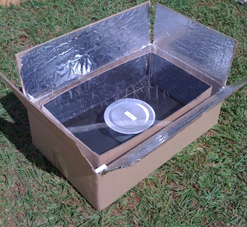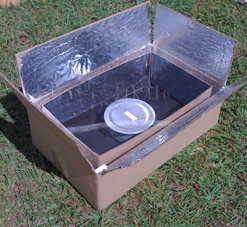
We all hate packaging, but the Kyoto box is that rare thing — a cardboard carton that’s part of the solution. It’s also the winner of Forum for the Future’s Climate Challenge competition with HP and the Financial Times to find the year’s best climate change-tackling innovation. After voting by FT readers and mulling over by an eminent panel including Eileen Claussen and Rajendra Pachauri, it’s the Kyoto box, a solar-powered cardboard cooker that will take away the $75,000 prize.
It’s aimed at the 3 billion people who use firewood to cook, and in the words of Kenya-based Jon Bøhmer, the entrepreneur behind the scheme, “We’re saving lives and saving trees. I doubt if there is any other technology that can make so much impact for so little money.”
The box costs about $6 to make, and ironically uses the greenhouse effect to boil and bake. It consists of two boxes, one inside the other, with an acrylic cover, which lets solar energy in and traps it. Black paint on the inner box and silver foil on the outer help concentrate the heat, while a layer of straw or newspaper between the two provides insulation. By making it possible to boil water cheaply, Bøhmer believes the box will save some of the millions of children who die each year from water-borne diseases. It should also halve the need for firewood, saving an estimated two tonnes of carbon per family per year.
Kyoto box was amongst 300 projects from around the world that entered the competition. The runners-up were:
- Mootral, developed by Neem Biotech in the UK — a feed additive, derived from garlic, which cuts the methane in cow, sheep and other ruminant burps and farts by at least 5%, and up to 25% with optimum dosage. Methane from ruminants is estimated to be responsible for 20% of global warming;
- Evaporating Tiles developed by Loughborough University, an indoor cooling system which works by using exhaust air to evaporate water within hollow tiles built into a false ceiling. It halves the energy use of air-conditioning systems and can be used as a standalone.
The other finalists were Carbonscape, a joint New Zealand/UK venture to fix biomass carbon by turning wood into biochar — a kind of charcoal that can be used as soil conditioner, buried as a carbon sink, or burnt as a highly-efficient fuel; and Deflecktor, created by ADEF in the USA, an inexpensive, lightweight aerodynamic cover for truck wheels reduces drag and can cut fuel consumption by 2% on an eight-wheel rig.
We’re very pleased with the way the Climate Challenge has shown how green innovation can tackle climate change, and hope all the finalists will now find a faster route to market. Bøhmer says publicity from the competition has already generated opportunities for his venture with a number of companies and academic institutions interested in the stove. He is planning to use the prize to conduct mass trials in ten countries and is also developing a more robust cooker in corrugated plastic, which he says can be mass-produced as cheaply as the cardboard version.
Carbon credits should help the project scale up: Bøhmer says they will cover the cost of the boxes as well as a package of other affordable low-carbon products including a solar torch. Distribution will be critical if the stove is to overcome cultural barriers to cooking without flames. Bøhmer plans to distribute the package free on condition that families use it, and aims to work with women’s groups in each community to build acceptability.



